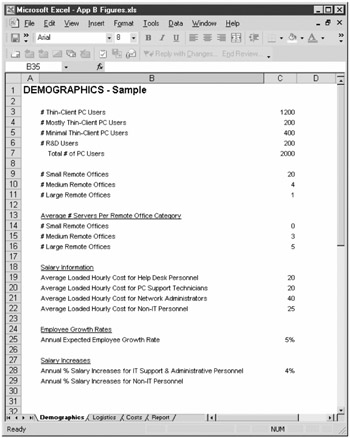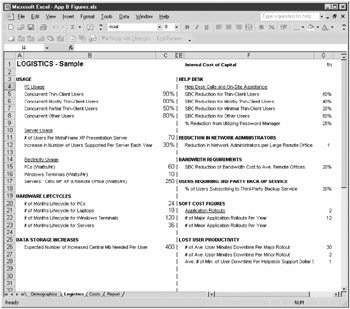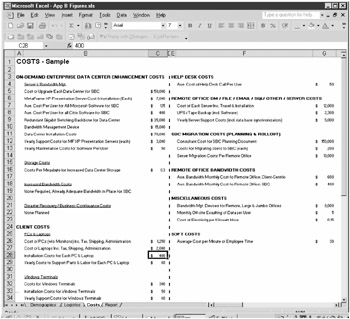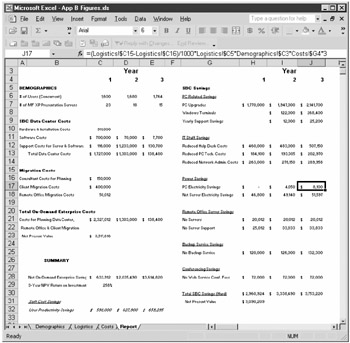Appendix B: Creating an On-Demand Enterprise Financial Analysis Model
|
Every organization's financial analysis will involve unique variables and methods of calculation, but you can use the model presented in this appendix as a framework for creating your own SBC financial evaluation. This model defines a method for identifying common costs and savings involved when migrating to enterprise server-based computing.
| Tip | The Citrix ACE Cost Analyzer (www.acecostanalyzer.com) is a great tool for providing a quick, high-level analysis of the type of savings that can be expected from deploying SBC. We contributed to both the concept and development of the ACE Cost Analyzer and frequently recommend it to our clients. The model we present here is intended as a more rigorous drill-down into specific anticipated product costs and benefits in order to present a compelling return on investment (ROI) to the key financial decision makers. |
Building a Spreadsheet Model
We recommend creating a spreadsheet that calculates both expected server-based computing costs and savings over a three-to-five-year time frame. The savings come from reducing the costs involved in a client-centric computing environment. These costs include both existing expenses and anticipated future expenses. For instance, if SBC enables you to eliminate the requirement to upgrade PCs as part of a regular refresh cycle, then the cost of purchasing and installing the PCs becomes an annual average savings under server-based computing.
It is not necessary to be creative when financially justifying an enterprise SBC project. The hard quantifiable savings alone should easily pay for the project and also provide a good return on investment. We recommend quantifying soft savings, such as reduced user downtime, and then listing these savings independently of the return on investment calculation. Although the value of certain benefits from implementing SBC can exceed that of the combined savings, we still recommend listing benefits separately as well. Taking this conservative approach makes a very strong statement to management about the overwhelming value of the project. It also helps the feasibility committee defend their evaluation against anyone who tries to poke holes in the financial analysis.
An effective financial model utilizes a multidimensional spreadsheet that isolates the different variables involved. This makes the spreadsheet both easy to follow and easy to adjust for different assumptions. We recommend creating a spreadsheet with four tabs: Demographics, Logistics, Costs, and Report.
Information entered into the Demographics, Logistics, and Costs sections will come from assumptions and research by the feasibility committee. The Report section will show the results of calculations derived from information entered into the other three sections.
In order to simplify the model, do not bother listing costs that are equivalent under both server-based and client-centric scenarios. For instance, if you plan to purchase new Windows Server 2003 file servers regardless of whether you build an on-demand enterprise or not, do not list the cost of these servers in your financial model.
| Note | This model is only a starting point for providing a thorough SBC financial analysis. When engaged to prepare an analysis for a client, we inevitably add many more detailed calculations based upon discovery of the specific organizational environment. |
Demographics
The number of users and remote offices participating in the SBC project are identified and categorized along with salary information for both IT staff and non-IT employees. Figure B-1 shows a Demographics spreadsheet example.

Figure B-1: Demographics section of a financial justification model
Number of Users
Whether employees or contractors, the number of expected SBC users should be estimated and categorized as to what degree of hosted applications they are likely to require. Common categorizations include thin-client, mostly thin-client, minimal thin-client, and other.
-
Thin-client These users will run their entire desktops from the Citrix server farm. They will either use Windows terminals or PCs configured as Windows terminals with local drive mapping disabled.
-
Mostly thin-client These users run the majority of applications from the Citrix server farm, but may still run some applications locally. Certain laptop users and users requiring unique applications often fall into this category.
-
Minimal thin-client These users primarily operate in client-centric mode and will use server-based computing selectively. This group might include headquarters employees who use client-centric PCs at work, but who like to dial into the network from home. It might also include salespeople who are often on the road, but who need to access corporate applications and databases. It might include remote PC users who simply like to save time by accessing their e-mail through MetaFrame XP Presentation Server rather than downloading it.
-
Other This category will differ by organization. It might include R&D engineers who want to run Windows applications on their UNIX workstations. It might include customers who run applications as anonymous Internet browsers utilizing Secure Gateway. Or it may be limited to a single company executive who insists on continuing to run the majority of his applications on a Mac.
Remote Offices
The composition of remote offices will have a big impact on the design of the server-based computing architecture. We recommend different categorizations such as home office, small office, medium office, large office, jumbo office, and regional office. Some general parameters follow, though of course they will be different for almost every organization.
-
Home office The home office is the new branch office. Telecommuters typically dial into the network or come in through the Internet. They sometimes use their own PCs and sometimes use company-issued PCs or laptops. If the organization implements a server-based computing environment, telecommuters are good candidates for inexpensive Windows terminals.
-
Small remote office Generally, these offices range from one to five users and have only low-bandwidth connectivity to headquarters, if any.
-
Medium remote office These offices range from 5 to 14 users. They sometimes have their own file and e-mail servers. Limited bandwidth connectivity is often in place.
-
Large remote office These offices range from 15 to 39 users. They often have their own servers and will sometimes have their own network administrators on staff. They frequently have high-speed bandwidth connections to headquarters.
-
Jumbo remote office These offices range from 41 to 200 users. They almost always have multiple servers and often have local network administrators in addition to high-speed bandwidth connections.
-
Regional office These offices have over 200 users along with IT support staff onsite.
Salary Information
Salary information should be listed for all categories of IT staff and should be loaded for FICA, workers compensation insurance, vacation, and so on. The average hourly loaded cost for non-IT personnel should also be listed. Include projected annual salary increase percentages as well.
Employee Growth Rate
The expected employee growth rate should be obtained from management. For simplicity, we usually assume that this growth rate will apply across the board to all categories of employees and to all locations. Of course, you may wish to fine-tune your spreadsheet with more specific calculations if appropriate. This information will be utilized to project increased IT resource demands.
Logistics
The Logistics spreadsheet section is for making assumptions about how usage and growth variables will impact users and equipment. Where appropriate, the logistics should reflect the specific user or remote-office categories defined in the Demographics section of the spreadsheet. Figure B-2 shows a Logistics spreadsheet example.

Figure B-2: Logistics section of a financial justification model
Internal Cost of Capital
The feasibility committee should obtain the organization's internal cost of capital from finance. This figure will be used to calculate the present value of both project costs and savings.
Usage
An SBC environment often enables economies in licensing, infrastructure requirements, and support because the number of concurrent users tends to be less than the number of total users. In some cases, this discrepancy can be very large. A multinational manufacturer based in California, for instance, saves a great deal of money on Citrix MetaFrame XP Presentation Server licenses because their users around the world operate in different time zones. The figures relating to user, server, and electricity usage include the following:
-
Concurrent users by category List the expected concurrency percentage for each category of users.
-
Server usage Calculate the number of users per MetaFrame XP Presentation server, which will enable you to calculate the total number of servers required in the Report section.
-
Increase in supported users each year As servers continue to become more powerful, they will be able to support much larger numbers of users. Estimating this percentage enables you to more accurately forecast the number of new and replacement MetaFrame servers required in the years ahead, which will continue to fall relative to the number of users accessing them.
-
Electricity usage Different manufacturers and products have a different KWH usage for their PCs and Windows terminals. HP currently has wattage requirements posted on their web site. Windows terminals commonly require up to 85 percent less electricity than PCs.
Hardware Life Cycle Estimates
In order to build a realistic financial model, the feasibility committee should estimate life cycles for PCs, laptops, Windows terminals, and servers. These figures should reflect the number of expected months of use for each device, like those listed next:
-
Personal computers The average realistic PC life cycle in most organizations seems to range between two and four years, though some organizations keep them even longer.
-
Laptops The average laptop's life expectancy is generally around two thirds that of PCs.
-
Windows terminals Since Windows terminals tend to have mean times between failure measured in decades, and since processing takes place on the MetaFrame servers, the Windows terminals' expected life cycle should easily exceed the time frame of the financial analysis.
-
Servers The life cycle for servers tends to range between two and four years. The increasing power of servers should also be considered when used to operate MetaFrame XP Presentation Server because it means that fewer servers can handle more employees. This makes it more economically compelling to centralize computing.
Data Storage
If appropriate, an estimate should be made for the increased centralized storage that will be required for each category of user once users become SBC clients.
Reduction in Help Desk Calls/Personnel
The feasibility committee should estimate the impact an SBC will have in reducing either help desk support calls or support personnel—depending upon how their organization accounts for this expense. For instance, IT may already charge users $100 per month for both phone and technician support. The feasibility committee might estimate that under server-based computing, support calls will decrease by the following amounts per category of user: thin-client, 80 percent; mostly thin-client, 60 percent; minimal thin-client, 20 percent; other, 80 percent.
Reduction in Network Administrative Personnel
This figure should reflect the lower number of administrators required as a result of eliminating servers in remote offices.
Bandwidth Considerations
Estimate bandwidth requirements for both a PC-based and server-based computing environment. These depend upon the applications utilized, the size of the remote offices, and the extent to which users are full thin-client users.
Third-Party Backup Subscriptions
Most PC-based computing environments allow users to maintain data on their local hard drives. If IT already backs up this data, then additional storage may not be required. If users are required to back up their own hard drives, then include this time as a soft cost for lost productivity. If a third-party service is utilized, include the percentage of users who subscribe to this service.
Soft Cost Figures
Soft costs are those costs that are harder to quantify, but that still clearly impact the organization.
Application Rollouts The estimated number of application upgrades or rollouts is used to calculate their costs, assuming that excess personnel or contractors are required to accomplish them. If your organization simply forgoes most application upgrades because of the huge cost of performing them within a PC-based computing environment, then having the latest software can be identified separately as a server-based computing benefit on the Report spreadsheet section.
-
Number of major application rollouts per year Rollouts of new application packages or operating systems
-
Number of minor application rollouts per year Software version upgrades
Lost Productivity
Estimate the amount of user productivity lost each year due to downtime and PC-based computing limitations such as inaccessibility to required corporate data.
-
Number of average user minutes downtime per rollout The expected length of downtime suffered by users for both major and minor rollouts.
-
PC upgrades The expected downtime users undergo when they receive a new PC.
-
Help desk delays The expected lost productivity time while waiting for the help desk to resolve a PC problem.
Costs
Estimated costs for both the existing PC-based computing environment and the proposed SBC are entered into the Costs section of the spreadsheet. Figure B-3 shows a Costs spreadsheet example. Where appropriate, modify costs to reflect the specific user category as defined in the Demographics section of the spreadsheet.

Figure B-3: Costs section of a financial justification model
An SBC Data Center
As discussed in Chapter 5, building an on-demand enterprise will involve configuring one or more data centers to support enterprise server-based computing. This is likely to require a more robust and redundant architecture than that of most existing PC-based computing environments. You may be able to upgrade your existing data centers, or you may wish to build new ones or co-locate them with a third-party service such as AT&T or Verio. The feasibility committee needs to choose a preliminary strategy, including the number of data centers, and assign appropriate costs for the model.
MetaFrame Servers Include both the cost and installation expense for each server.
Windows Server 2003 Software Microsoft licenses Windows Server 2003 Terminal Services on either the basis of total number of users or devices. See Chapter 2 for licensing details.
Citrix Software Citrix software is licensed on a concurrency basis, as explained in Chapter 3. In addition to the basic MetaFrame XP Presentation Server licenses, most organizations also purchase at least some of the other MetaFrame Access Suite components, including MetaFrame Secure Access Manager, Password Manager, and Conferencing Manager.
LAN Backbone As discussed in Chapter 6, an SBC data center requires a very robust LAN backbone. This usually means a minimum 100MB switching configuration and may include FDDI or gigabit switching for larger implementations along with redundancy.
Bandwidth Management If you have remote offices, you may want to consider utilizing bandwidth management, as discussed in Chapter 6. One good solution is to use a bandwidth management device such as Packeteer's PacketShaper. These units can easily pay for themselves by increasing the utilization of available bandwidth from 40 to 80 percent.
Installation Ensure enough money is allocated to properly install all of the data center components. Remember that much of the work may have to be done during off-hours in order not to disrupt your current environment.
Maintenance and Support Include estimated costs for both annual maintenance and support of hardware and software.
Storage Costs
Estimate the cost per megabyte for required increased data-center storage to support the SBC users.
Electricity Costs
Include the company's average cost per kilowatt.
Increased Bandwidth Costs
Although the bandwidth costs to remote offices may fall under server-based computing, the data center bandwidth requirements may increase.
Disaster Recovery/Business Continuance
The feasibility committee needs to determine the extent to which the SBC will include disaster recovery and business continuance. The associated costs should then be entered into the spreadsheet.
Client Costs
The cost for PCs and laptops includes sales tax, shipping, and administration. Software operating system costs are included along with annual hardware support costs. A realistic installation cost should reflect the hours it takes to configure each device. For most organizations, this ranges between three to eight hours per PC or laptop.
The lack of any moving parts makes the installation and annual support costs for Windows terminals minimal.
Help Desk Costs
Some organizations will show help desk costs as reductions in the number of support personnel required. Others might already have an assigned monthly support cost per user.
Remote-Office Server Costs
Servers in remote offices will usually be eliminated under an SBC scenario. It is therefore important to estimate the costs for these servers, including ancillary equipment such as tape backups, tape backup software, uninterruptible power supplies and software, network O/S software, and network management software. Include costs for installing new servers along with the costs for annual server maintenance.
Conferencing Costs
Several Internet conferencing programs charge fees to enable sharing of documents to both internal personnel and external clients. They typically charge by the minute. Exclusive of telecommunications costs, fees commonly range around .30 to .50 per minute, or about $50 to $150 per month per user.
Migration Costs
Estimate the costs for migrating PC users to server-based computing desktops, including the cost of migrating the data to the corporate data center. Four hours for migrating each PC is probably a reasonable figure. Include the estimated cost to migrate information from remote office servers back to the corporate data center. Also include the cost for preparing the project definition and planning documents, as well as the infrastructure assessment.
Remote-Office Bandwidth Costs
Compare the cost of bandwidth required for a PC-based computing environment with the cost for providing adequate bandwidth connectivity for a server-based computing environment. Both figures will depend upon the size of remote offices and the bandwidth medium. Using the Internet or a VPN is likely, for example, to be much less expensive than using a dedicated leased line or frame relay connection. Server-based computing could either reduce or increase the bandwidth cost to a remote office depending upon the number of users and applications required. Effective use of an ERP application in a remote office, for instance, may require much higher bandwidth under PC-based computing than under server-based computing.
Miscellaneous Costs
This category includes the miscellaneous additional costs for both the server-based and PC-based computing environments. Examples include costs for bandwidth management devices for the larger offices and the cost of using a third-party service to back up user hard drives.
Soft Costs
The cost of employee time shown on a minute or hourly basis should be entered into this part of the spreadsheet.
Report
The Report section pulls together all of the information from the Demographics, Logistics, and Costs sections of the spreadsheet. The end result is a net present value estimate for building an SBC and for the savings it is expected to generate over a three-to-five-year time frame. The present value of the total savings can then be divided by the present value of the total cost of the project to show the expected return on investment for the SBC initiative.
We like to list the categories in the first column and then the summarized costs for the ensuing years in the following columns, as seen in Figure B-4, which shows an example of a Report spreadsheet section over a three-year analysis period.

Figure B-4: Report section of a financial justification model
Demographics Summary
We find it useful to recap the total number of expected concurrent employees by year, along with the number of expected MetaFrame servers required in a demographics summary. Since technology is almost certainly accelerating faster than your employee growth rate, the number of servers required each year should actually decline.
SBC Costs
SBC costs are the summation of all the different components involved in constructing and maintaining an on-demand enterprise data center.
| Tip | You may wish to break down costs and savings on a per-user basis in order to analyze the impact of an SBC from a different angle. |
Data Center Costs In the sample shown in Figure B-4, we consolidate the costs by hardware and installation, software, and support costs.
Migration Costs
Migration costs include the project definition, infrastructure assessment and planning costs, as well as the client migration costs and remote-office migration costs.
SBC Savings
As mentioned earlier in the appendix, the SBC savings equate to the money not spent that would have been required to sustain a PC-based computing environment.
PC and Laptop Savings PC and Laptop Savings section summarizes the expected savings from less-frequent upgrades of PCs and laptops. The figures come from multiplying the total cost of the laptop or PC by 12 and dividing it by the life cycle of the device. For instance, suppose a PC costs $1250, including taxes, installation, shipping, and administration. If your company policy is to replace PCs every 18 months, then your annual savings by going to server-based computing will be $1250 (12 / 18) = $833 per PC. If appropriate, the annual maintenance savings for PCs and laptops should also be reflected in this category.
Windows Terminal Savings Windows terminal savings result from being able to purchase less-expensive Windows terminals rather than PCs for new users. In the example in Figure B-4, we assume that PCs will gradually be replaced with Windows terminals as they come up in their normal refresh cycle.
Yearly Support Savings Yearly support savings are a result of using Windows terminals or from using PCs locked down like Windows terminals rather than fat-client PCs for new users.
IT Staff Savings
The amount of decreased help desk support, PC desktop support, and remote office network administrator support required under an SBC should be summarized by showing a decline in either the monthly charge per user or in a reduced salary cost for IT personnel.
| Note | According to a 2003 Gartner Research Report, password-related help desk calls account for nearly 25 percent of call volume, on average. This means that implementing the Password Manager component of the MetaFrame Access Suite alone should generate significant reductions in help desk staffing requirements. User productivity will also be increased since users no longer will need to wait for the help desk to assist them with forgotten passwords. |
Remote-Office Server Savings
Remote-office server savings result from no longer having to upgrade and maintain remote-office servers. The annual savings from not having to upgrade the servers are calculated in the same manner as the savings from not upgrading PCs and laptops.
| Note | All servers in remote offices may not be eliminated under an SBC model, depending upon factors such as the size of the office and bandwidth availability. If any remote office servers will remain under SBC, then the calculations will need to be modified appropriately. |
Power Savings
Electricity savings are included for the replacement of PCs with Windows terminals, and for the elimination of remote-office servers (adding back the increased electricity usage for the Citrix servers in the data centers).
Conferencing Savings
Citrix MetaFrame Conferencing Manager also enables real-time application sharing for both internal and external users, but at a one-time fixed fee that is included as part of the SBC software cost. Conferencing savings are therefore the annual expense of the organization's web-based conferencing service.
Backup Savings
Any hard backup savings such as the money that will no longer be required for third-party backup services are reflected here. Any soft backup savings are quantified apart from the ROI calculation.
Summary
Subtract the SBC costs from the anticipated savings to show the net SBC savings each year.
Calculate the expected ROI of an SBC by subtracting the net present value of the SBC costs from the net present value of the SBC savings. Then divide this figure by the net present value of the SBC costs.
Soft Savings
Show soft savings apart from the ROI calculation, and include savings from reduced user downtime and inaccessibility to required corporate data. Specific productivity savings can also be calculated from utilizing the Password Manager and Secure Access Manager components of the MetaFrame Access Suite.
Benefits
List the expected benefits from implementing an SBC along with the financial report. It might even be appropriate to quantify some of them, but excluding them from the ROI calculation should still leave a project savings easily large enough to justify the SBC implementation.
|
EAN: 2147483647
Pages: 158